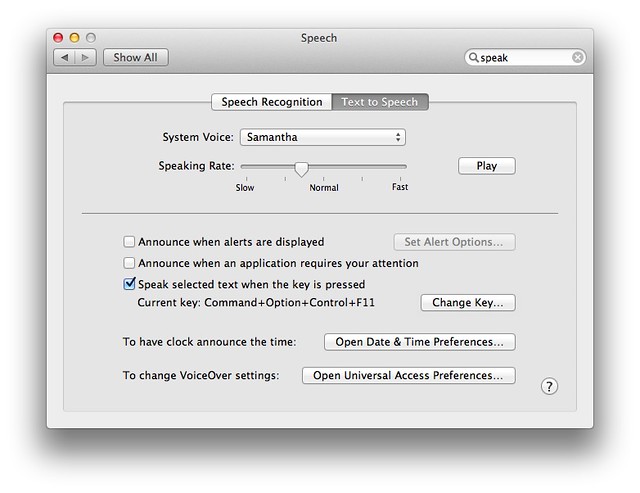Ignoring my own advice
December 23, 2011 at 9:34 PM by Dr. Drang
Back in June, I wrote a post in which I pointed out how much easier it is to catch errors in your writing if you use the Mac’s Text to Speech feature. At the end of the post, I said
Despite the effectiveness of these tricks, I don’t use them nearly as often as I should. I do one or the other with every report I write for clients, but I’m usually too impatient to use them on my blog posts. It shows; almost every post has a typo or two. Maybe posting this will shame me into using them more often.
Today, I wrote this on Twitter:
I can’t believe I’ve didn’t know this exists. Crosby, Stills, Nash, Young, and Jones.
Tom Jones.
youtube.com/watch?feature=…!
I am ashamed of the illiteracy, but shame isn’t going to allow me to go back in time and fix it. That tweet will stand forever as a testament to my carelessness, eventually enshrined in the Library of Congress.
As you’ve probably guessed, the I’ve is there because that tweet started out in a different form, a form in which I’ve had a purpose. But because I can barely write a single sentence without going back and revising it, the tweet was edited and the I’ve didn’t get edited to match the new form.
This is, I suspect, the most common type of error in writing today.1 Back in the typewriter days, people wrote in drafts that were typed from start to finish. “I’ve didn’t know this exists” is very unlikely to come out of the fingers of someone who can’t move the cursor back and forth.
I remember reading a reminiscence by Lester Del Rey, a golden-age science fiction writer I’ve mentioned before, in which he said his practice was to retype his entire story after every round of editing, even when he could’ve gotten away with just retyping a page or two, because it made the story flow better if he typed it in the same order it was read.
Nowadays, we may use the word draft, but most of us don’t really write that way. Even people who can write an entire piece from start to finish without fiddling never retype the whole thing. Once they have a chunk of text to work with, it’s cut and paste, insert and delete, here and there, just like the rest of us.
But back to my point: If the Mac’s Text to Speech is so easy to use, and so effective at finding mistakes like this, why don’t I use it all the time? Laziness, impatience, and hubris are the main reasons. I’m too lazy to invoke Text to Speech (even though it’s only a swipe and a keystroke away), I don’t want to wait to listen to it, and how could I possibly miss a mistake in such a short piece? Contrary to Larry Wall’s pithy saying, laziness, impatience, and hubris aren’t always virtues.
A small thing that gets in my way of using the feature more often is the default keystroke assigned to the Speak Selected Text function: ⌥⎋ (Option-Escape). This is pretty clumsy and hard to remember because it doesn’t involve the ⌘ or ⌃ keys, as every other keyboard shortcut does. I’ve changed it on my MacBook Air to ⌃⌥⌘F11.
I chose F11 because the big symbol on that key is that of a speaker with sound waves coming out; it’s the Volume Up key. To get it to act like F11 instead of Volume Up, I have to press the fn key along with Control, Option, and Command. It’s easy to do this with my left hand because they’re all in a row down at the lower left corner of the keyboard.
I’m under no illusion that this keystroke change will suddenly get me to change my ways. Old habits break only when new habits are adopted. But making it easier to do the right thing can’t hurt.
One last thing: the video I linked to in the illiterate tweet really is amazing.
-
I’m considering only writing done by the relatively literate. YouTube comments don’t count. ↩



